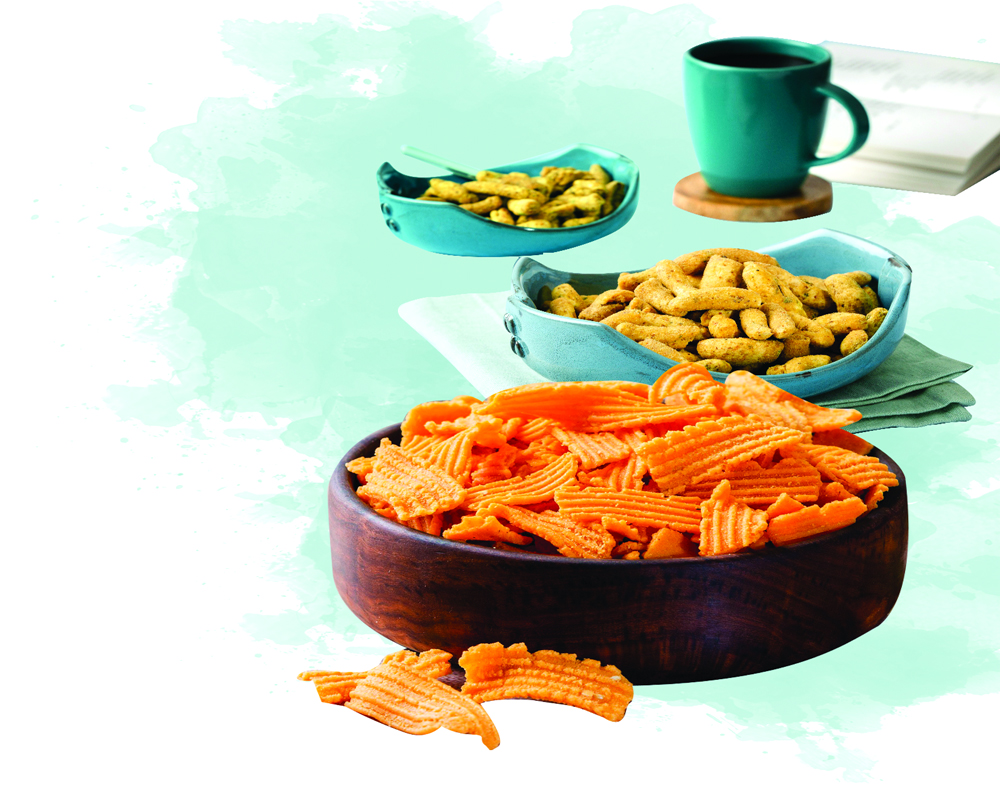With multiple brands providing accessible options for different snack preferences and slots, we are spoilt for choice, says Ashish Nichani, as he lends insight into the changing snacking habits and preferences of the Indians
From your living room to office, in your handbag and in the glovebox of your car; and on every journey you can remember — there has always been an omnipresent companion — your favourite snack.
Snacking has always been a part of our culture. Those hunger pangs before lunch... That little something with chai... And with the passage of time, we have only added more snacking occasions to our busy lives. Can study or work be complete without a pack by your side? And what fun is the latest Netflix show if there isn’t something chatpata to match the histrionics on screen!
To speak numbers, all of this translates into a snacking industry that’s worth INR 1 Billion which continues to expand at scorching double digit growth rates.
The pandemic has only enhanced our love for snacks. A recent survey by the FMCG giant Mondelez revealed that 88% of Indians were snacking more than before the pandemic with a large majority of millennials and those working extended hours from home preferring snacking over meals. With entertaining also becoming a home-bound activity, snacks have also proved to be a convenient and hygienic replacement to a restaurant starter.
Our fascinating love for snacks has prompted many surveys and the findings are telling. When we see a snack, we don’t just see a packet. We see comfort in that wrapper. We see snack time as our break from the routine. A source of momentary happiness. We also see snacks as a complement or substitute for nourishment. These findings are direct or obvious. And therefore, they are very significant insights into the changing nature of our lives. Evidently, we expect a lot more from our snacks than just flavour!
While our snacking habits may seem like evolution, our snacking choices are undergoing a revolution. To someone born in the 80s, snacking typically meant munching on chips or namkeen — remember that transparent plastic wrapper filled with salted potato chips or peanuts or a local mixture? If it was a branded snack picked at a store, it would be Pepsico Lays chips or Haldirams Bhujia.
My earliest recollection of the first innovation in snacking as a consumer came along with the launch of Kurkure back in 1999 — a new flavour and a new form. Unfortunately, very little has changed in offline retail today as these legacy brands and products continue to dominate shelf space. Retailers have also made no effort at innovation or disruption but have launched private labels with the same legacy products.
For the mass-affluent and beyond, food is more than just nutrition. It’s also a way of enjoying life, a treat for the senses. But where is that joy when you get served the same food again and again?
It’s only thanks to brave entrepreneurs who have chosen to tread the difficult path of disrupting their industry enabled by e-commerce that we have seen our snack choices really explode in the last few years.
Yeh dil maange more!
The evolution of snacking is oddly similar to the evolution of marriage. For the longest time, marriage decisions were made between a few choices. You made your peace with that and made it work. But today, you can swipe right and left, you can date and flirt, you can cohabitate and then eventually you can choose to settle down with your choice. This is precisely how our approach to snacking has also evolved. Today, we demand and have access to far more choices than ever before!
As Indians, we started travelling a lot more in the last decade. And the more we travelled, we exposed our taste buds to more cuisines. India is home to 4,635 communities spread across its geographical expanse and each region has its own snacking culture and taste profile. For example, the snacks in Kerala have a distinct aroma of coconut oil, those of Punjab and UP are more hearty, the mixtures of the East have more jhal (spice) while the Kathiyawadi style is intense in its sweet-savoury combination. In comparison, the snacks of the Chettinad are more mildly flavoured.
Each of these microcultures also has its own repertoire of snacks. For example, have you tried the Kolhapuri Bhadang that is made in Jaysinghpur of Maharashtra? Or the Sattur Sev of Tamil Nadu? How about the kachoris of Jamnagar? Or the Bhakarwadi of Pune? That sense of adventure and that joy of tasting and liking something new — all those experiences added up to the fun of travelling across the country. Today, thanks to e-commerce, all these unique local foods are available to us through a few brands and e-retailers who are challenging the status quo foisted upon us by big FMCG companies over the years.
On a national level, Postcard (www.thePostcard.in) helps in discovering local flavours of snacks, sweets and pickles across geographies with a promise of authenticity, quality and service. There are region-focussed options such as Gujaratisnacks.in (Gujarat), Pettikadai.in/Nativespecial (Tamil Nadu), Indorinamkeen.com/TasteofIndore etc which bring out the specialities of their respective regions.
Consumers too appear to enjoy this journey of discovering new foods. It’s not uncommon to hear people in Gurgaon talk about how they enjoy the Bihari thekua as a desi cookie. Or consumers in the Guwahati who are getting to try South Indian flavours like Murukku, Thattai, etc. Local food discoveries have become a conversation starter, a badge of pride for the adventurous and a common joy to share within the family.
Keep it clean
Today, health and wellbeing are an important consideration and this aspect is being reflected in snacking choices too. We see a wave of snack brands focused on superfoods — from kale-based snacks by Green Snack Co to the millet based Soulful and Healthy Cravings Co. These brands use superfoods as ingredients to create familiar snacks and flavours with enhanced nutrient profiles (such as higher fibre). Imagine how comforting it would be to not feel any pang of guilt while snacking! The challenge of course lies in adoption of new ingredients by the palate.
Trail Mixes of nuts and seeds are another superfood-packed snack choice. A few brands have tried to popularise these options although they have faced headwinds in view of the higher price points involved.
Besides superfoods, there is also a trend of clean eating. For the longest time people were unaware of the ingredients going into their food choices. But today, we see a lot more awareness and brands are doing their best to respond to this need. For example, there is an emphasis on avoiding the use of colouring additives or preservatives as much as possible even though these are permitted by law (with the necessary safeguards, of course). Smaller local brands such as Pure & Sure Phalada have introduced snacks made with organic ingredients!
The Wonder Bar
Alongside the typical snack forms of chips, namkeen and extruded snacks, we see bars emerge as a snack of choice for the younger generations. The younger generation that works odd hours or seeks convenience prefer the range of energy bars while protein bars are preferred by consumers who seek targetted nutrition.
Energy bars first made an appearance in the 1960s when the American FMCG giant Pillsbury introduced them as “Space Food Sticks” claiming that the bars had a balance of all nutrients. It has taken the bar form 50 years to reach its current popularity.
Bars have caught on in India over the last two to three years. There are a number of brands vying for this space with Yoga Bars having the first mover advantage. Insurgent brands such as The Whole Truth are successfully disrupting this space with a disarmingly honest approach to clean eating with a functional focus.
Looking ahead
As the pandemic fear recedes and we emerge into a new normal, it will be interesting to see how our snack choices evolve with our lifestyle and the impact of these changes on business. While I’m no soothsayer, here are three ideas for the common good:
- It’s high time that retailers adopted a customer-centric approach by understanding their changing needs and aspirations. From food preferences to food allergies, the Indian customer has distinct needs and these need to reflect on the shop shelf. For the consumer who seeks diversity, the shelf must incorporate local flavours which change in sync with the seasons. Similarly, the health food section must have options for vegans, gluten-allergies, calorie-conscious folks, elders, children, office-goers etc. The one generic “healthy” option would not cut it.
- With their scale and expertise, the legacy FMCG companies have a responsibility to adapt and assist the ecosystem. There are many brands with unique food products that emerge only to fade away due to the lack of financial or operational muscle-power that is critical to survive in the offline channel. Can a partnership model evolve between the big and small that is mutually beneficial?
While the benefits to the small brands are obvious, big brands will also get an insight into how smaller companies are able to do more with less. We see this happen in the personal care space. Take the example of the Bombay Shaving Company, a homegrown brand of mens personal care that has received investment from global FMCG majors Colgate Palmolive & Reckitt Benckiser. It’s time that Indian FMCG brands entered such partnerships so that new-age companies have an option other than VC investments.
- Fresh fruit is one of the most under-served snack options. It is easily available on street corners but hygiene is a concern. Can either brands or retailers work on models that transform the vending of cut fruit as nutritious snacks? That would be a genuine healthy clean snacking option that benefits customers, retailers and farmers.
The beauty about the snacking industry is that there is space for everyone.
Each of us have a few fixed slots for snacks in our day. And there is a preference of a kind of snack for each of those slots. With multiple brands providing accessible options for each of these preferences and slots, we are spoilt for choice. A golden age of choice has dawned.
(The writer is an entrepreneurin the Indian Food industry anda local food enthusiast)


























